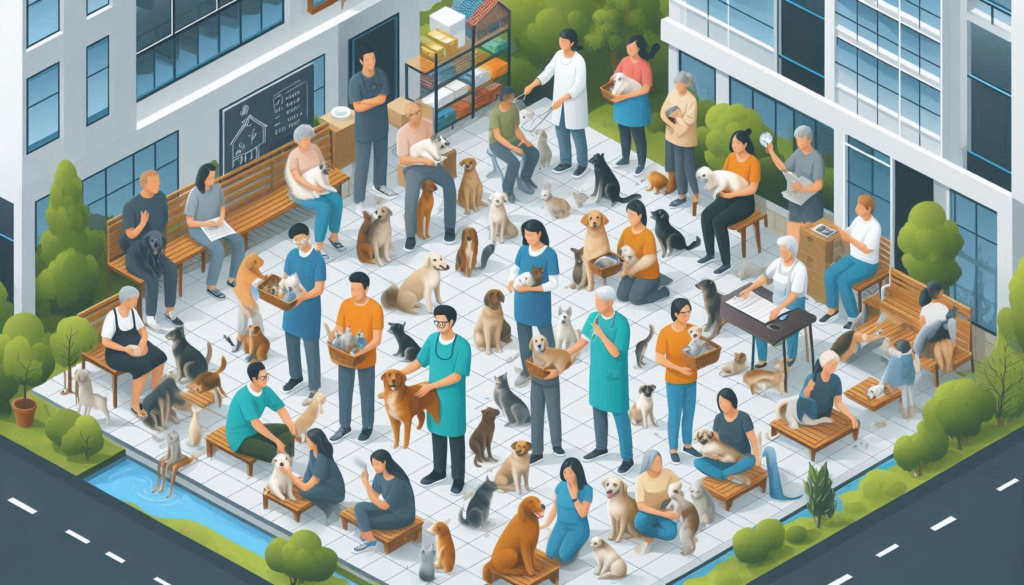
In the bustling heart of India’s cities, stray dogs and cats weave themselves into the daily fabric of urban life. Yet, despite their presence, they often face a harsh reality of neglect and indifference. What if there was a way to transform this narrative, to turn stray animal welfare into a community-driven triumph? Welcome to a new vision where cooperative housing societies become the champions of stray animal care. This article explores a compassionate, practical, and sustainable approach to improving the lives of these animals while fostering a sense of community responsibility.
A Call for Compassion: Why Community-Based Solutions Matter
Imagine a neighborhood where stray animals are not seen as a problem but as fellow residents deserving of care and kindness. Picture a community where the wellbeing of strays is intertwined with human compassion, leading to a harmonious coexistence. This vision is not a distant dream but a tangible goal within reach through the initiative of cooperative housing societies.
“Compassion is not a sign of weakness; it’s the bridge that connects us all,” and by extending this bridge to stray animals, we can build a society where empathy is a common thread.
Reducing Fear and Promoting Kindness
The fear surrounding stray animals often stems from misconceptions and a lack of understanding. By educating residents on humane treatment and coexistence, we can dissolve these fears. Knowledge is power, and when people learn to approach stray animals with kindness rather than apprehension, the entire community benefits.
“Understanding is the first step towards empathy; once we see the world through others’ eyes, our hearts grow larger.”

Legalizing Animal Care: Turning Compassion into Action
Laws recognizing animal rights exist, but their practical application often falls short. By establishing clear guidelines within cooperative housing societies to ensure the care of stray animals, we can bridge the gap between legal standards and everyday reality. Enforcing these guidelines can help create a structured, compassionate approach to animal welfare.
“Legal rights without practical care are like dreams without action—fleeting and empty. It’s time to turn our legal ideals into everyday reality.”
Preventing Diseases: A Proactive Approach
Regular vaccinations and sterilizations are crucial for preventing disease and controlling stray populations. By incorporating these practices into community routines, we not only safeguard the health of the animals but also protect public health. It’s a win-win scenario where prevention leads to a healthier environment for everyone.
“Prevention is a silent hero—saving lives before problems even arise.”
Fostering Empathy through Education
Education plays a pivotal role in shaping attitudes towards animals. By introducing programs in schools and community centers that emphasize compassion and responsible pet ownership, we can nurture a generation that views animals as deserving of kindness and respect.
“Education plants the seeds of empathy; nurture them, and a garden of compassion will bloom.”
Bridging the Gap: Addressing the Challenges
1. Legal vs. Reality
Despite laws protecting animal rights, stray animals often lack the care they deserve. This discrepancy between legal frameworks and real-world practices highlights the need for community-based solutions that put legal principles into action.
“Laws are the foundation; community action is the building that brings those laws to life.”
2. Mixed Attitudes
Public attitudes towards stray animals vary widely. Some view them as a nuisance, while others advocate for their protection. This divide results in inconsistent care and enforcement. A community-driven approach can help standardize and harmonize these attitudes, leading to more consistent and humane treatment.
“Diverse opinions are a strength, not a barrier. When we unite for a common cause, we turn differences into collective strength.”

3. Uneven Law Application
The application of laws like the Prevention of Cruelty to Animals Act is often inconsistent. By integrating animal care into the fabric of community life, we can ensure that these laws are not just written words but lived practices.
“Consistency in care is not a choice; it’s a responsibility we all share.”
4. Lack of a Comprehensive Solution
Currently, there is no one-size-fits-all solution for managing stray animals across different communities. The proposed model of cooperative housing societies provides a practical, adaptable framework that can be tailored to various residential settings.
“A comprehensive solution starts with one community taking the first step; from there, others will follow.”
Why This Project is Essential
Stray Animals in Urban Life
Stray dogs and cats are integral to urban ecosystems. Proper management is essential not only for the animals’ welfare but also for community safety. Ignoring this issue only perpetuates the cycle of neglect and harm.
“Every stray has a story; it’s up to us to ensure their story ends with hope, not hardship.”
Inhumane Solutions Don’t Work
Removing or euthanizing stray animals is a short-term fix that fails to address the root of the problem. It disrupts ecosystems and does not prevent new animals from filling the void. A community-based care model offers a humane, long-term solution.
“True solutions heal, not harm. Let’s choose compassion over convenience.”
Community-Based Care: A Viable Approach
Cooperative housing societies are perfectly positioned to implement this model. Their existing community structure makes them ideal for organizing and managing stray animal care in a structured and effective manner.
“In unity, there is strength; in collective action, there is change.”
The Urgency of Immediate Action
Rising Stray Populations
The growing number of stray animals poses increasing challenges. Without immediate, organized intervention, the situation will worsen, leading to more significant problems for both the animals and the community.
“The time for action is now; tomorrow is a luxury we cannot afford.”
Overloaded Shelters
Shelters are often overwhelmed and cannot keep up with the rising stray population. A community-based approach can alleviate some of this burden by distributing the responsibility among residents.
“Shared responsibility lightens the load; together, we can make a difference.”
Need for a Sustainable Model
Urbanization is rapidly increasing, making the need for a sustainable, community-driven model more urgent. This approach not only addresses immediate concerns but also builds a foundation for long-term success.
“Sustainability is not a choice; it’s the only path to a future where both humans and animals thrive.”
Success Stories and Practical Achievements
At my college, Nari Gursahani Law College, we have seen the positive impact of organized stray animal care. Our initiative provides feeding, health care, and a safe environment for stray animals on campus. This success demonstrates that a structured approach to animal welfare can be both practical and effective.
“What starts as a small step can turn into a giant leap for change.”
Interview Insights: The Benefits of Pet Ownership
Interviews with pet owners highlight the profound benefits of having pets, especially during the COVID-19 pandemic. Pets provide emotional support, reduce stress, and create a sense of purpose. These experiences reinforce the value of integrating stray animals into community settings.
“In every wagging tail and purring kitten, there lies a story of comfort and connection.”
Economic Efficiency and Social Relevance
Economic Benefits
Community-based care for strays reduces individual costs and allows for bulk purchasing of supplies. It also provides opportunities for external funding and sponsorships.
“Shared costs are shared gains; together, we turn savings into solutions.”
Social Impact
Caring for strays fosters community unity and promotes compassion. It also sets an example for other communities and increases the appeal of neighborhoods known for their humane practices.
“Compassion is contagious; let’s spread it far and wide.”
Practical and Scalable Solutions
The model is adaptable to various residential settings, making it a versatile solution. Its scalability ensures that more communities can adopt similar practices, creating widespread positive change.
“The best solutions are those that can grow and evolve with the needs of the community.”

Conclusion
The proposed initiative of integrating stray animal care into cooperative housing societies offers a compelling, compassionate solution to a pressing issue. By harnessing the collective strength of communities, we can bridge the gap between legal ideals and practical realities. This model not only improves the lives of stray animals but also fosters a culture of empathy and shared responsibility. It’s a call to action—a chance to transform how we interact with the world’s most vulnerable inhabitants.
Ultimately, the success of this community-based model lies in its ability to transform stray animal care from a mere responsibility into a shared cultural value. By empowering residents to take proactive roles in this cause, we foster a sense of belonging that extends beyond human neighbors to include all living beings in our urban environment.
This is more than just about solving a logistical problem; it’s about reshaping our mindset, where every act of compassion for stray animals is a step toward creating more compassionate cities. When we care for the most vulnerable, we elevate the collective spirit of the community, proving that small, consistent efforts can lead to profound societal change. “In the end, a society’s progress is measured not by its wealth, but by how it treats its most helpless members—both human and animal alike.
“In every act of kindness, we find the power to change lives—let’s use that power to build a future where every paw finds a place to belong.”





1 thought on “Paws and Laws: A Community-Based Solution for Stray Animal Welfare”